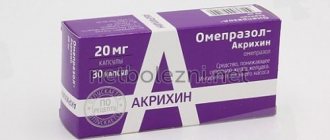Omeprazol-Teva
Dosage 10 mg
The drug is taken orally at a dose of 10 mg once a day.
Capsules are usually taken in the morning, preferably separately from meals, swallowed whole, with half a glass of water. Capsules must not be chewed or crushed. If swallowing is difficult, the contents of the capsule, after opening it, can be mixed with a slightly acidified liquid (juice, yogurt) and used within 30 minutes. If there is no effect within three days, examination by a specialist is necessary. The maximum course of treatment without consulting a doctor is 14 days.
Dosage 20 mg and 40 mg
Capsules are usually taken in the morning, preferably separately from meals, swallowed whole, with half a glass of water. Capsules must not be chewed or crushed. If swallowing is difficult, the contents of the capsule, after opening it, can be mixed with a slightly acidified liquid (juice, yogurt) and used within 30 minutes.
Duodenal ulcer
In case of exacerbation of duodenal ulcer, it is recommended to take the drug 20 mg once a day. Typically, the duration of therapy is 2 weeks; if necessary, it is possible to increase the course of therapy for another 2 weeks. Patients with duodenal ulcer resistant to treatment are usually prescribed the drug 40 mg once a day for 4 weeks. To prevent relapses for patients with duodenal ulcer - 20 mg 1 time per day; in some cases, 10 mg once a day may be sufficient (capsules containing 10 mg of omeprazole must be used). If necessary, the dose can be increased to 40 mg 1 time per day.
Stomach ulcer
For exacerbation of gastric ulcer, the recommended dose of the drug is 20 mg once a day. Duration of therapy is 4 weeks. In cases where complete healing does not occur after the first course of using the drug, a repeat 4-week course of treatment is prescribed. Patients with gastric ulcers resistant to treatment are usually prescribed the drug 40 mg once a day, healing is usually achieved within 8 weeks. To prevent relapses, patients with gastric ulcers are recommended to take the drug at a dose of 20 mg once a day. If necessary, the dose can be increased to 40 mg 1 time per day.
Helicobacter pylori eradication regimens for peptic ulcer disease:
- omeprazole 20 mg, clarithromycin 500 mg, amoxicillin 1000 mg simultaneously 2 times a day for 1 week;
- omeprazole 20 mg, clarithromycin 250 mg (alternatively 500 mg), metronidazole 400 mg (or 500 mg or tinidazole 500 mg) simultaneously 2 times a day for 1 week;
- omeprazole 40 mg once a day, as well as amoxicillin 500 mg with metronidazole 400 mg (or 500 mg or tinidazole 500 mg) both 3 times a day for 1 week.
The recommended dose of omeprazole in Helicobacter pylori eradication regimens in pediatric practice is 1-2 mg per kilogram of child body weight per day.
In cases where after treatment the patient is Helicobacter pylori positive, a second course of treatment is possible.
Treatment of ulcerative-erosive lesions of the stomach and duodenum associated with the use of NNVN*.
The recommended dose of omeprazole is 20 mg once a day. The course of treatment is 4 weeks. For patients whose ulcers have not healed, the course can be extended for another 4 weeks.
* (non-steroidal anti-inflammatory drugs)
Prevention of ulcerative-erosive lesions of the stomach and duodenum associated with taking NSAIDs
As a prophylaxis of NSAID-associated ulcerative-erosive lesions of the stomach and duodenum in patients at risk (age over 60 years, history of ulcerative-erosive lesions of the stomach and duodenum, history of bleeding from the upper gastrointestinal tract) recommended dose - 20 mg omeprazole once a day.
Treatment of reflux esophagitis
The recommended dose is 20 mg of omeprazole once a day. The course of treatment is 4 weeks. For patients who have not recovered within this period, the course can be extended by 4 weeks. For severe esophagitis, the recommended dose is 40 mg omeprazole once a day, and the course of treatment is 8 weeks.
For maintenance therapy in patients with reflux esophagitis, the recommended dose of omeprazole is 10 mg once a day (capsules containing 10 mg of omeprazole must be used). If necessary, the dose can be increased to 20-40 mg 1 time per day.
Symptomatic treatment of GERD
The recommended dose is 20 mg per day. Individual dose adjustment is possible. If symptoms persist after 4 weeks of treatment with omeprazole 20 mg daily, further evaluation is required. The recommended dose of omeprazole for the treatment of GERD in pediatric practice is 0.7-3.3 mg per kilogram of child body weight per day. Treatment of non-ulcer dyspepsia
The usual dose is 10 mg (1 capsule) per day. The maximum daily dose of the drug should not exceed 20 mg. The maximum course of treatment is 14 days. If symptoms do not improve within 2 weeks or if they worsen, you should consult a doctor.
Treatment of Zollinger-Ellison syndrome
The dose is set individually. The recommended starting dose is 60 mg once daily. If necessary, the dose is increased to 80-120 mg per day. Doses greater than 80 mg should be divided into two doses.
Use in children over 2 years of age and body weight > 20 kg in the treatment of reflux esophagitis and the symptomatic treatment of heartburn and acid regurgitation in GERD
In children over 2 years of age weighing more than 20 kg, the recommended dose is 20 mg once a day. The dose may be increased to 40 mg once daily if necessary.
The course of treatment for reflux esophagitis is 4-8 weeks, for symptomatic treatment of heartburn and sour belching with GERD - 2-4 weeks. If symptoms persist after 2-4 weeks, the patient requires additional examination.
Treatment of duodenal ulcer caused by H. pylori in children over 4 years of age
When choosing the appropriate combination therapy, official local and national recommendations in terms of bacterial resistance, duration of treatment (most often 7 days, but sometimes up to 14 days may be required) and appropriate antibacterial agents should be taken into account.
Treatment is carried out under the supervision of a specialist.
In children weighing 15-30 kg: use in combination with 2 antibiotics: omeprazole - 10 mg, clarithromycin and amoxicillin in this category of patients are prescribed in a dosage regimen according to the instructions for the use of clarithromycin and amoxicillin (used simultaneously 2 times a day for 1 weeks).
In children weighing 31-40 kg: use in combination with 2 antibiotics: omeprazole - 20 mg, clarithromycin and amoxicillin in this category of patients are prescribed in a dosage regimen according to the instructions for the use of clarithromycin and amoxicillin (used simultaneously 2 times a day for 1 weeks).
In children weighing more than 40 kg: use in combination with 2 antibiotics: omeprazole
20 mg, clarithromycin and amoxicillin in this category of patients are prescribed in a dosage regimen according to the instructions for use of clarithromycin and amoxicillin (used simultaneously 2 times a day for 1 week).
Dosage regimen for special groups of patients
For liver failure, 10-20 mg is prescribed (maximum daily dose 20 mg); in case of impaired renal function and in elderly patients, no dosage adjustment is required.
Pharmacodynamics
Omeprazole inhibits the enzyme H+-K+-ATPase (“proton pump”) in the parietal cells of the stomach and thereby blocks the final stage of hydrochloric acid synthesis. This leads to a decrease in the level of basal and stimulated secretion, regardless of the nature of the stimulus. After a single oral dose of the drug, the effect of omeprazole occurs within the first hour and continues for 24 hours, the maximum effect is achieved after 2 hours. In patients with duodenal ulcer, taking 20 mg of omeprazole maintains intragastric pH = 3 for 17 hours. After stopping the intake of the drug, secretory activity is completely restored after 3–5 days.
Side effects
In rare cases, the following usually reversible side effects may occur.
From the digestive system: diarrhea or constipation, nausea, vomiting, flatulence, abdominal pain, dry mouth, taste disturbances, stomatitis, transient increase in the level of liver enzymes in plasma; in patients with previous severe liver disease - hepatitis (including jaundice), impaired liver function.
From the nervous system: headache, dizziness, agitation, drowsiness, insomnia, paresthesia, depression, hallucinations; in patients with severe concomitant somatic diseases, in patients with previous severe liver disease - encephalopathy.
From the musculoskeletal system: muscle weakness, myalgia, arthralgia.
From the hematopoietic system: leukopenia, thrombocytopenia; in some cases - agranulocytosis, pancytopenia.
From the skin: itching; rarely (in some cases) - photosensitivity, erythema multiforme, alopecia.
Allergic reactions: urticaria, angioedema, bronchospasm, interstitial nephritis and anaphylactic shock.
Other: blurred vision, peripheral edema, increased sweating, fever, gynecomastia; rarely - the formation of gastric glandular cysts during long-term treatment (a consequence of inhibition of hydrochloric acid secretion, which is benign and reversible).
Directions for use and doses
Orally, with a small amount of water (the contents of the capsule must not be chewed).
Duodenal ulcer in the acute phase - 1 caps. (20 mg) per day for 2–4 weeks (in resistant cases - up to 2 capsules per day).
Gastric ulcer in the acute phase and erosive-ulcerative esophagitis - 1-2 caps. per day for 4–8 weeks.
Erosive and ulcerative lesions of the gastrointestinal tract caused by taking NSAIDs - 1 caps. per day for 4–8 weeks.
Eradication of Helicobacter pylori - 1 caps. 2 times a day for 7 days in combination with antibacterial agents.
Anti-relapse treatment of gastric and duodenal ulcers - 1 caps. per day.
Anti-relapse treatment of reflux esophagitis - 1 caps. per day for a long time (up to 6 months).
Zollinger-Ellison syndrome - the dose is selected individually depending on the initial level of gastric secretion, usually starting from 60 mg/day. If necessary, the dose is increased to 80–120 mg/day, in which case it is divided into 2 doses.
special instructions
Before starting therapy, it is necessary to exclude the presence of a malignant process (especially with a stomach ulcer), because Treatment, masking symptoms, can delay the correct diagnosis.
Taking with food does not affect effectiveness.
If you have difficulty swallowing a whole capsule, you can swallow its contents after opening or dissolving the capsule, or you can mix the contents of the capsule with a slightly acidified liquid (juice, yogurt) and use the resulting suspension for 30 minutes.
In patients with severe liver failure, the daily dose should not exceed 20 mg.
Pharmacokinetics
Omeprazole is rapidly absorbed from the gastrointestinal tract, Cmax in plasma is achieved in 0.5–1 hour. Bioavailability is 30–40%. Plasma protein binding is about 90%. Omeprazole is almost completely metabolized in the liver. T1/2 - 0.5–1 hour. Excreted mainly by the kidneys in the form of metabolites. In chronic renal failure, excretion decreases in proportion to the decrease in creatinine clearance. In elderly patients, excretion decreases and bioavailability increases. In case of liver failure, bioavailability is 100%, T1/2 is 3 hours.


